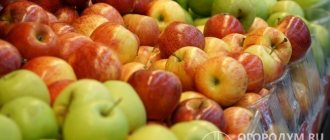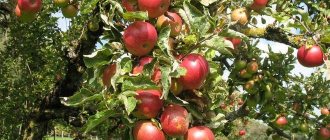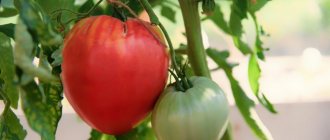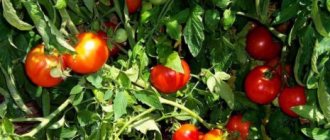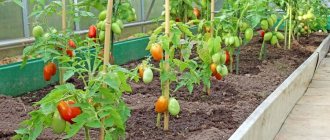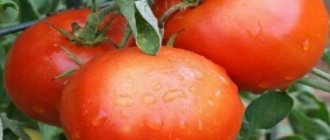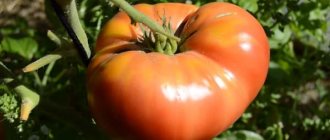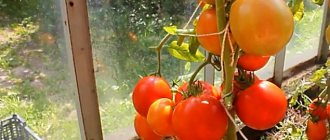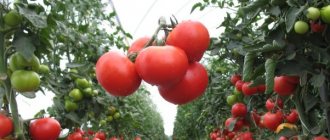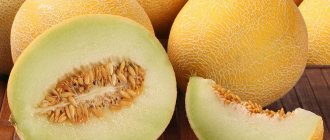The variety of apple tree varieties bred by breeders is striking in their quantity and ripening period of apples. Among the winter varieties, the Carnival variety is distinguished by its characteristics. Fruits with an excellent dessert taste and unusual skin color, which are stored for a long time and are a source of useful vitamins in winter.
Carnival - unusual apples.
Description of the variety
The Carnival apple tree is a hybrid obtained by crossing the stable Skoroplodnaya apple tree variety and the Spartan variety, which is distinguished by the good taste of the fruit. A distinctive feature was the appearance of the fruit, alternating yellow and bright red stripes.
Advantages and disadvantages
The Carnival variety has a number of advantages due to which gardeners appreciate it. Among them:
- taste and appearance of fruits;
- resistance to scab;
- frost resistance.
The apple tree has no obvious shortcomings.
Description of the tree
The tree is medium-sized, 4.5-5 meters high. It is not too thick, the crown is rounded, the branches are drooping. With proper care of the apple tree, you can form the plant on a trunk or in the shape of a bowl.
Description of fruits
Apple Carnival.
During the ripening period, Carnival apples have a skin with greenish and bright red stripes; during the harvest period, yellow stripes alternate with bright red ones.
The weight of the fruit ranges from 160 to 180 grams. The pulp is juicy, dense, white. The taste is sweet and sour, dessert.
The color of each apple is individual, as if painted with a brush.
Immunity and disease resistance
The variety has good immunity to scab and fruit rot. He practically never gets sick even in the harshest conditions. But experts advise not to neglect preventive spraying.
Frost resistance
The apple tree has good resistance to winter frosts. Even in conditions of return frosts, the apple tree shows a high level of resistance.
Apple tree flagship. Early varieties
It is generally accepted that early varieties of apples are those that ripen in midsummer. But, there are varieties that ripen at the beginning of the summer season. These fruits have a sour taste, but delight with their ripeness already in June or early July.
Early ripening ones include:
- White filling is very popular. Green apples with a yellow tint when fully ripe. A tree with a pyramidal crown bears fruit well. Originally from the Baltic states, it is resistant to cold and disease;
- Golden china is a drought-resistant species. The apple tree begins to bear fruit in the third year, producing fruit earlier than other early-ripening varieties. Sweet yellow apples do not last long, but they can be used to make jams and preserves;
- Moscow Grushovka is known in different regions of Russia. It is not whimsical and resistant to frost. Fragrant sweet and sour fruits ripen gradually. During long-term storage, apples lose their taste;
- Korobovka. A tall, frost-resistant apple tree with a spreading crown bears fruit of small size. Fragrant and sweet yellow-green apples are perfect for canning;
- Arkadik is a tall, powerful tree with a wide crown, very viable, and tolerates temperature changes well. Sweet and sour arcadicas have a spicy flavor;
- An early sweet variety characterized by flat fruits of light yellow color and sweet taste. The tree is low with a spreading crown and tolerates frost well;
- Super Prekos bears fruit for the first time in the fourth year. Precuts can be stored for a long time and tolerate transportation well. Sweet and juicy medium-sized apples.
Fruiting
The Carnival variety is productive; to avoid overloading the tree, it needs to be rationed. However, such remarkable fruits could not go unnoticed and the variety has already interested many gardeners.
Productivity and precocity
Indicators of the amount of harvest taken from one tree vary and are different in different sources. There is data about 70 kg, but there are also figures of 130 kg.
The first apples can be collected already in the third year after planting an annual seedling. But there won’t be many of them, just try. But already in the fifth year the harvest becomes full.
Harvest and storage
Apples are ready for picking in mid-September, sometimes even a little later. They, although winter, can be eaten immediately after collection. But the shelf life is quite impressive, up to 6 months.
Landing
When planting the Carnival variety, you must comply with a number of requirements as for any other varieties:
- choose a deadline;
- determine the location;
- purchase a seedling;
- plant correctly.
Timing and seedlings
Depending on the region and climatic characteristics of the area, planting is scheduled for spring or autumn. If planted:
- in the spring, then you need to choose a time after the soil has warmed up well, but before the buds have blossomed;
- autumn, then the time is selected so that the harvest has already been harvested and the leaves have fallen, but there are about 21 days left before the first frost.
Seedlings must be purchased only from trusted places, because other similar varieties may be passed off as an unusual variety. They must be visually intact and healthy.
Carnival seedlings with a closed root system are often sold. This option will be preferable. The plant will not be damaged during transplantation and can be moved into the ground at any time.
Selection and preparation of a site
In order for the apple tree to be comfortable on the site, it must meet certain requirements:
- the soil must be fertile and loose;
- the place is level;
- groundwater is located deeper than 2 meters;
- maximum in a lighted area;
- at a sufficient distance from other crops.
The pit for planting must also be prepared in advance. For this:
- it is dug out to a suitable size, 80*80 cm;
- the top layer of fertile soil is removed separately, but not thrown away;
- add fertilizers and wood ash;
- water and leave.
Depending on the timing of preparation and planting, you need to start preparing 2-3 weeks in advance, or 30 days in advance.
Apple tree planting diagram.
Landing technology
After all the preparations have been made, you can proceed directly to planting. It is done quite simply:
- in a hole you need to make a hill from the soil.
- Place a seedling on it.
- Spread out the roots.
- Sprinkle with soil and water.
- Mulch the tree trunk circle.
- Make sure that the neck of the root remains above the ground level.
Apple tree planting diagram.
Apple tree carnival description photo reviews
The Carnival apple tree was bred for the 1000th anniversary of the city of Elabuga.
The hybrid was obtained by combining the hereditary code of the Skoroplodnaya apple tree, which has a mediocre taste of apples, but very high vitality, with the gene structures of the Spartan apple tree with very high taste qualities.
The new type of apples have a very high taste, weigh 150-160 grams, are one size, with thick skin, dark red color over the entire surface.
The color of the skin is uneven - at different stages of ripening it can change from green to yellow, and then the entire fruit is covered with an appetizing pink blush, through which a honey-golden color peeks through.
The pulp is dense, juicy, with a dessert taste.
Apple tree "Carnival"
-winter variety with consumption period - until March.
The apple tree plant is medium in height.
The main concern in apple tree farming is to eliminate soil acidity to around neutral pH by introducing various limestone deoxidizers.
If there is a gley horizon in the soil thickness - this is observed in damp places with close groundwater - it is advisable to “move the apple tree away from it” by creating an embankment.
Planting is carried out on a prepared area after forming a hole and applying fertilizer. For planting, choose a sunny place, protected from the wind. The groundwater level is at least one meter.
Important! Apple trees grow best on loam.
The soil for the tree must be fertile, with good moisture and air permeability. The composition of clay soil is improved by adding coarse sand and peat. Sandy soil is fertilized with peat, humus and compost. It is recommended to begin preparations in the fall.
The planting site is dug up and fertilizers are applied: • turf – 3 buckets; • humus – 5 kg; • superphosphate – 100 g; • wood ash – 80 g.
A hole measuring 0.5 x 0.5 m and a depth of 0.6 m is prepared for planting. The hole is filled with the prepared mixture, a peg is driven in and covered with special material until spring.
Immediately before planting, you need to place the roots of the seedling in warm water for a couple of days. The plant is placed in the middle of the hole and its roots are straightened. The root collar (the place where the bark changes color to dark brown) is located 5 cm above ground level. When filling the apple tree with soil, you need to shake it slightly to fill the voids between the roots. Then the soil is trampled down and the plant is watered abundantly. A small earthen bank with a diameter of about a meter is poured around the tree. If the soil begins to settle, more soil should be added. The apple tree is tied to a support.
The growth of the apple tree and its productivity depend on proper care. Young garden trees require special attention. The apple orchard needs to be regularly watered, fertilized and pruned:
Let us immediately outline the main rules for this culture.
1. Fertilizer for an apple tree should not be abundant or concentrated. It is better to fertilize the apple tree little by little every year than to give shock doses once. It is best to fertilize the apple tree annually with small doses of compost or humus, just a few buckets for each tree, trying to pour and dig in fertilizer this year where it was not there in the past. The tree trunk circle can be divided in half or into three parts, and fertilize them in turn year after year. At the same time, it is not necessary to spread the fertilizer and then dig it in evenly: it is enough to do it half a bayonet to each bucket locally where you poured it out. The roots of an apple tree are able to “find and densely entwine” places where organic matter accumulates in the soil.
With this method of adding organic matter, we simultaneously carry out a gentle, leisurely rejuvenation of the tree roots.
In this case, the tree, firstly, is guaranteed to have time to completely restore the roots cut the day before, and secondly, these new young roots are given enough time to express themselves.
Important! A severe stress for an apple tree is the annual uniform digging of fertilizers over the entire area of the trunk circle.
Advice: the rule of moderation in fertilizers saves a fruit-bearing tree from fattening when, instead of laying flower buds, it suddenly switches to growing long shoots for several years.
Fattening a tree is an imbalance, a gardener's mistake, an excessive amount of nitrogen.
These numerous long shoots throughout the crown are of no value to us. They only lead to a drop in yield through thickening of the crown, so the owner of such an apple tree will have to work hard with pruners to straighten the situation and force the crown to be evenly covered with fruit branches again.
2. The fertilizer used should not be physiologically acidic.
A big mistake is made by gardeners who grow their garden with granular mineral fertilizer, even if it has a very favorable nutrient composition. Acidification of the soil negates all the benefits of good initial growth of a tree in a powerful planting hole, since it will certainly affect the organism of the apple tree.
3. Fertilizer must be applied in a timely manner.
Mid-autumn is the best time.
Approximately the first half of October (permissible at the end of September or in the second half of October).
Thus,
A) fertilizer applied in the fall has a whole range of beneficial effects on the tree:
• moderate cutting of roots in autumn stimulates abundant fruiting in the next season; • the appearance of fertilizer in the soil sets the tree up for “optimism” from the very spring (which does not work so well when applying fertilizer in the spring: the “tuning” begins in the fall); • experiencing an acute nitrogen deficiency at the end of the season for the normal ripening of shoots for winter (in particular for the formation of a waxy coating on the branches, which is important for winter hardiness), the tree suddenly receives nitrogen at the right moment and manages to “draw it in” with young roots and use it for tissue preparation in November to frost.
Agricultural technology
The care requirements are quite simple. They are the same as for any other varieties. This:
- proper watering;
- fertilizers;
- trimming and shaping;
- preventive measures.
Watering and fertilizing
Water the young crop often, once every fourteen days for the first year. An adult apple tree needs less moisture, only 3-4 times per season, but 50 liters of water.
Fertilizers are applied according to the standard schedule:
- spring elements of nitrogen;
- in summer complex feeding;
- organic in the fall.
Fertilizers are applied with watering or dry to the tree trunk circle. In some cases, the crop is sprayed with mineral fertilizers on the leaves.
Pruning and crown formation
Carnival lends itself well to shaping and responds to sanitary pruning. The most important thing is to carry out the procedures correctly and in a timely manner.
To form the correct shape of the crown, you need to gradually remove the side shoots, leaving only the skeletal ones, until the skeletal shoots are completely formed. As it grows, it will be necessary to remove shoots that duplicate the skeletal ones and stand out from the overall picture.
Sanitary pruning should be carried out twice per season, in spring and autumn. During the procedure, branches that have suffered from diseases, pests or are broken are removed. This procedure is necessary to maintain the health of the apple tree.
After pruning, you need to cover the large diameter cuts with garden varnish.
Apple tree pruning diagram.
Prevention measures
The Carnival apple tree variety has fairly decent immunity. But in order to maintain it, a number of measures must be observed:
- remove weeds and loosen the tree trunk in a timely manner;
- carry out preventive spraying;
- whitewash the trunk and wrap it for the winter;
- mulch the tree trunk circle.
